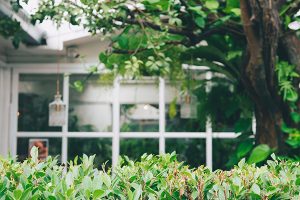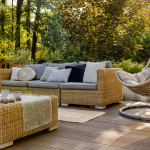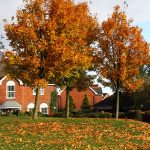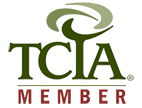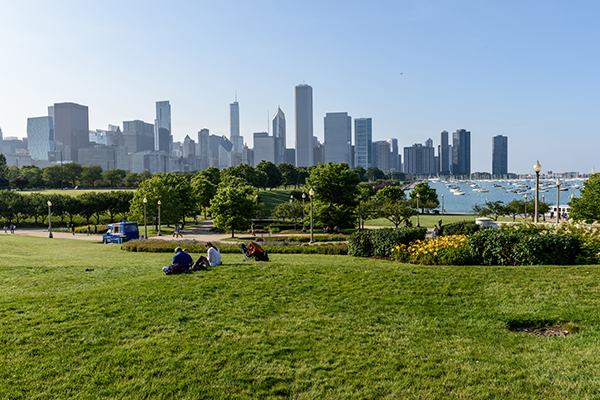
Shade trees provide beauty and a place to relax & enjoy in any Chicago landscape, consider planting a shade tree in your yard today
Updated for 2024! Summer in the Chicago area is off to a hot start as we have already experienced a record number of 90-degree days and this hot weather is expected to continue through the entire summer. Chicago area residents should take steps to keep themselves and their homes cool this summer and find some relief from the heat.
One way you can keep your property cooler through the summer is by planting a good shade tree in your yard. If you are into landscaping, then you already know the benefits of a good shade tree. Shade trees are large trees with widespread canopies that can provide a good amount of shade over your yard and home. There are many different types of summer shade trees native to the Chicago area that you can plant in your yard to help reduce the temperature on your property. In this article, we will explain the benefits of planting a summer shade tree, discuss the best ways to plant the tree, and identify the most common types of shade trees in the Chicago area.
If you already have a summer shade tree in your yard and would like the help of professional arborists to take care of it, Hendricksen Tree Care can help. We provide complete tree care and maintenance services that include fertilization, pruning, and treatments for insects or disease for any type of tree native to the area.
Benefits of Planting a Summer Shade Tree in Illinois
The most basic benefit of planting a shade tree in your yard is that it will cool the air with the shade it provides. Shade trees also help clean the air and bring a nice breeze into the yard to keep the temperature cool. The cooling and shading effect provided by these trees can result in the following benefits on your property:
- Lower Energy Bills: Planting a shade tree to provide shade to your home can help reduce your energy bills by keeping your home cooler. Providing shade to your home or your outdoor AC unit has been shown to reduce cooling bills up to 10 percent. If you do plant your shade tree to shade the AC unit, make sure you plant it more than 3-4 feet away so the unit can get the air movement it needs to function properly.
-
Shade for your Home: Putting a shade tree in the right place around your home can effectively reduce the heat coming into your home from the sun. It is important to know where to plant the tree to properly shade your home. Planting shade trees to the east and west of your home will provide the best shade from the rising and setting sun. You must take into account the height and width of your tree once matured to ensure that it will provide adequate coverage where you plant it. If your shade trees are expected to grow taller than 25 feet, they should be planted 10-20 feet away from the home.
- Shade for your Yard: Providing shade to your yard can help keep the temperature on your property low, especially if you plant them to shade your driveway and sidewalks. The sun beating down on concrete or asphalt can create a heating effect that will make the area feel several degrees hotter. Shading your concrete and asphalt surfaces will keep them cool and prevent the Urban Heat Island effect.
How to Plant your Summer Shade Tree
Once you have picked out your shade tree and decided where you want to plant it, you can begin the planting. The following tips will help you properly plant your shade tree:
- Start by digging a hole deep enough to fit the root ball but 2-3 times wider.
- Remove all ropes and the top half of the burlap around the root ball.
- Use existing soil to fill in around the root ball.
- Lay down 2-3 inches of organic mulch around the tree but away from the trunk.
- If needed, drive a stake into the ground outside the root ball and tie the tree trunk to the stake using nylon or plastic for stabilization. The stake can be removed 1 year after planting.
- Put a loose tree guard around the trunk for protection. This guard can be removed after 1 year.
- Prune away branches that are rubbing, crossed, or damaged, but do not prune the lead branch.
However, it may be best to have a professional arborist plant your shade tree to ensure that it is planted properly, contact Hendricksen Tree Care for help with our tree planting services .
Recommended Shade Trees in Chicago
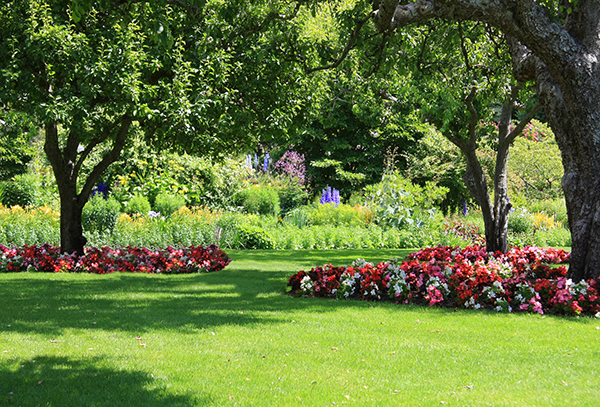
What type of shade tree will you choose to plant in your Chicagoland landscape? Call Hendricksen Tree Care for additional options to find the perfect fit for your yard.
There are a number of trees native to the Chicago area that make great shade trees, including maple trees, oaks, elms, and lindens. Ash trees are also native to the Chicago area and provide great shade, but we do not recommend planting an ash tree due to the problems caused by the emerald ash borer. The following shade trees are recommended by the Chicago Park District:
- Red Maple Hybrid: The red maple hybrid (Acer freemanii) is a hybrid of a red maple and silver maple that can grow 40-60 feet tall and 20-40 feet wide, making it a great shade tree. These trees are known for their red leaves in the fall and produce red flowers early in the spring, making them a good ornamental tree as well. Red maple hybrids grow faster than other species of maple and they are more resistant to disease. They must be planted in the spring.
- Sugar Maple: Sugar maples (Acer saccharum) are the most common native maple trees found throughout the Chicago area and greater Midwest. They grow to be between 60 and 75 feet when fully matured with a width between 40 and 50 feet. They are best known for their lush green foliage in the summer and vibrant fall colors that range from red to orange. These maples should also be planted in the spring.
- Red Oak: Red oak trees (Quercus rubra) are fast growing oaks that can get between 60 and 75 feet tall and wide. These trees are resilient to weather in the Midwest and they provide impressive color all year, budding pinkish-red in the spring, dark green in the summer, and bright red in the fall. It is best to plant red oak trees in the spring.
- Common Hackberry: The common hackberry (Celtis occidentalis) is a tree native to the Chicago area that has a long lifespan similar to oak trees. These trees grow between 40 and 60 feet high and 40-50 feet wide when fully matured. They are known for their pale grey bark and purple berries, and their leaves turn yellow in the fall.
- Ginkgo: Ginkgo trees (Ginkgo biloba) are very hardy trees that can grow between 50 and 80 feet in height. They are easily recognizable by their fan-shaped leaves that are green in the summer and yellow in the fall. The broad, pyramidal shape of the ginkgo’s canopy makes it a great shade tree.
- Kentucky Coffeetree: The Kentucky Coffeetree (Gymnocladus dioicus) grows to be between 60 and 75 feet tall and it has a high tolerance to pollution and various soil types which makes it ideal for urban settings like Chicago. The leaflets of the Kentucky Coffeetree provide shade and they turn golden yellow in color in the fall.
- American Linden: The American Linden, or American Basswood (Tilia americana), is a dense shade tree with heart-shaped leaves and an open crown. They can grow 60 to 80 feet tall and they produce fragrant cream-colored flowers that attract a variety of birds. The leaves of the American Linden are dark green in the summer and turn pale yellow in the fall.
- American Sycamore: The American sycamore tree (Platanus occidentalis) is a fast-growing sycamore that can quickly provide your property with shade. These trees can grow up to 6 feet per year and they have a thick canopy with many branches. They only need a little bit of water and sun to grow, and they can thrive in warm and cold climates. In the fall, the large leaves turn into a golden yellow color. The bast time to plant an American sycamore tree is in the late winter or early spring.
- Weeping Willow: The weeping willow (Salix babylonica) is a species of willow tree native to northern China, but it has been planted throughout the world for its unique “weeping” aesthetic. These trees can grow to between 30 and 50 feet, growing as fast as 6-8 feet per year. Their outward canopy provides an excellent amount of shade while adding a unique element to the aesthetic of your landscape. Weeping willows should be planted in the late spring or early fall in an area where they can get full sunlight.
- Tulip Poplar: The tulip poplar (Liriodendron tulipifera) is a flowering shade tree that can grow up to 70 feet tall. The flowers that form on the tulip poplar are tulip-shaped, yellow-orange flowers that appear from April to June. In the fall, the leaves of the tulip poplar change colors to a bright yellow. These trees are highly resistant to insects and diseases and can grow in a wide range of soil types. You can plant a tulip poplar in your yard any time between the spring and early fall.
- Cold Hardy Mimosa Tree: The cold hardy mimosa tree (Albizia julibrissin) is a fast-growing shade tree that can add some color to your landscape. Hundreds of full, pink flowers bloom around mid-June and can last until September. This is also a very hardy tree as it can withstand cold temperatures, snow and ice, drought, and heat, making them able to survive any conditions the Chicago climate may throw at it. The best time to plant a cold hardy mimosa tree is in the late spring.
- Heritage River Birch: The heritage river birch (Betula nigra) is a common shade tree that grows up to 50 feet tall at 2-3 feet per year. It can thrive in any type of soil, and it is resistant to disease as well as conditions such as modest drought, mild floods, strong wind, and ice. These trees also have peeling bark that can stand out in your landscape. It is best to plant heritage river birch trees in the spring or fall.
Plant a Shade Tree in your Chicagoland Area Landscape Project
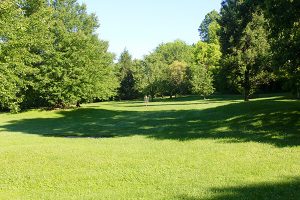
Whether you are in Chicago, Arlington Heights, or anywhere in between in the northwest Illinois suburbs, now is the best time to plant your summer shade tree!
The addition of a shade tree to your yard or landscape will provide you with many benefits including cooler temperatures and shade for your property, lower energy bills, and a more interesting landscape with a tall beautiful tree. It is best to plant summer shade trees in the spring, but some can be planted early in the summer and even in the fall. If you need the assistance of a professional to plant a native shade tree in your yard or care for your existing shade trees, talk to our arborists at Hendricksen Tree Care. Our tree care experts are very knowledgeable about the native trees of Chicago and can provide effective tree care and maintenance services to keep your trees healthy.
To learn more about our tree care services, contact Hendricksen Tree Care by calling (847) 348-8302. You can also learn more about the native trees of the Chicago area in our native tree blog series.

